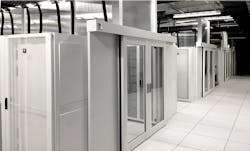Depicting the True Value of Airflow Containment
In this week’s Voices of the Industry Sam Rodriguez, Sr. Product Manager of Cabinet & Thermal Solutions for Chatsworth Products share some great advice on airflow containment strategies.
Sam Rodriguez, Sr., Chatsworth Products.
Properly managing hot exhaust temperatures produced by computer, data storage and network equipment is one of the most complex challenges data center managers and operators face on a daily basis. It’s a juggling act of keeping equipment functioning at optimal temperatures and keeping management happy by reducing cooling and operating costs.
By developing and implementing a good airflow containment strategy, it is possible to remove hot spots and achieve a lower Power Usage Effectiveness (PUE) as a result. Improved hot/cold air isolation results in more savings.
If you compare a room with and without an airflow containment strategy, the room without isolation will require more chilled air mass, translating to more HVAC equipment (air handlers, etc.) and more capacity required from the cooling system, consuming additional energy.
With an effective airflow isolation strategy, airflow capacity can be fine-tuned to match actual equipment requirements. Airflow containment allows reliable control of inlet intake temperatures for equipment, which means room temperatures can be increased. Engineers can plan for these higher temperatures and find savings by making adjustments to the cooling design. Computer Fluid Dynamic (CFD) analysis will typically show that fewer air handlers are required, even taking redundancy into consideration. The result is that a proper airflow containment design can eliminate some of the upfront capital expense of a project by reducing equipment to meet capacity, while still delivering intended results.
Future-Ready Designs
With equipment densities continuing to increase, allowable inlet equipment temperatures will also continue to rise. The American Society of Heating, Refrigeration, and Air-Conditioning Engineers (ASHRAE) currently recommends an intake temperature of 80.6°F, but next-generation equipment is designed to operate at higher temperatures. ASHRAE provides the recommended allowable range for intake higher temperatures, but implementing airflow containment can take advantage of this recommendation and allow additional energy savings.
Here’s how…
Start with cabinets. Hot/cold air separation should start within the cabinet. Within cabinets, unnecessary openings allow pressurized exhaust air to be pushed to equipment intake ports and should be sealed to create complete hot/cold air isolation. Air dams, filler panels, bottom panels, brush grommets, and other sealing accessories can deliver best possible isolation.
Once isolation is achieved within the cabinet, take the same approach to the entire room. There are three basic options, each yielding similar performance but different deployment methods, strategies and lifecycle costs:
1. Vertical Exhaust Duct – A Vertical Exhaust Duct at the top of the cabinet guides hot air to the return system. This is good way to isolate the equipment exhaust from the room because the interior back of cabinet will be hot, but the room will be cool.
Deployment is fairly simple because this is a cabinet-centric strategy. There are minimal lifecycle costs since there are no moving parts. This is a perfect strategy for new or retrofit installations of high- to mid-density output.
2. Hot Aisle Containment (HAC) – This strategy features a barrier that surrounds the “hot” aisle and provides a return path for hot air. It includes doors at the ends of adjacent cabinet aisles and an overhead Vertical Exhaust Duct. The room will be cool, and the contained aisle will be hot.
HAC implementation requires a more complex deployment and higher investment cost to implement. The HAC system is adaptable to the site, but must be field-fitted to the row. It must be deployed on an entire aisle with paired cabinet rows and missing cabinet spaces must be blocked with full height panels. The higher cost compared to Vertical Exhaust Duct strategy is primarily due to the deployment by rows, requirement for End of Row Doors (not required with Vertical Exhaust Duct cabinets) larger duct walls, and additional labor to attach the containment system to the room.
Most innovative manufacturers these days will offer a customizable and flexible solutions that can fit in any retrofit application.
3. Cold Aisle containment (CAC) – Contrary to the HAC strategy, this features a barrier that surrounds the “cold” aisle and traps cold air so that it must travel through equipment. This is possible through a “lid”/ceiling over the aisle and doors at the ends of adjacent cabinet aisles. The room will be hot, while the contained aisle will be cold.
Like HAC, CAC has its complexities during installation. It must be deployed by an entire row and also has the additional requirement for End of Row Doors. In addition, CAC typically requires design changes to the fire suppression system. As a result, higher installations costs are frequent. Lifecycle costs are similar to that of HAC, but one potential issue with CAC is that when used in a high-density application, the volume of the contained space may limit the amount of cold air that can be delivered to equipment in the event of a cooling equipment failure.
Overall, the energy savings benefits of airflow containment—be it Vertical Exhaust Ducts, HAC, CAC are irrefutable. The proven benefits are so well recognized that local, state and federal governments have passed laws requiring data centers to use airflow containment strategies to comply with strict energy efficiency guidelines set by the U.S. Environmental Protection Agency.
Before implementing your own airflow containment strategy, consider you facility’s unique design and equipment requirements. Also look for reputable manufacturers that provide an array of design tools to help you visualize and plan your projects seamlessly.
At Chatsworth Products (CPI), it is our mission to address today’s critical IT infrastructure needs with products and services that protect your ever-growing investment in information and communication technology. We act as your business partner and are uniquely prepared to respond to your specific requirements.

